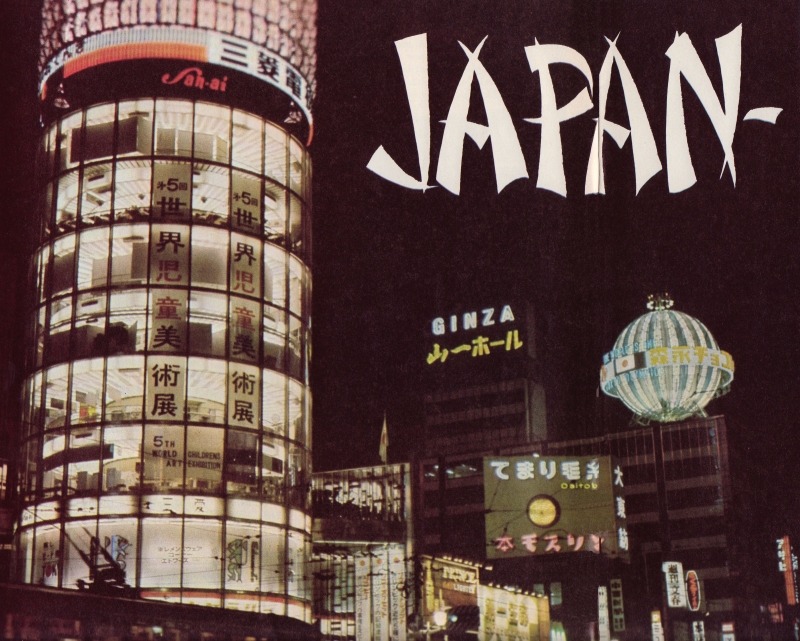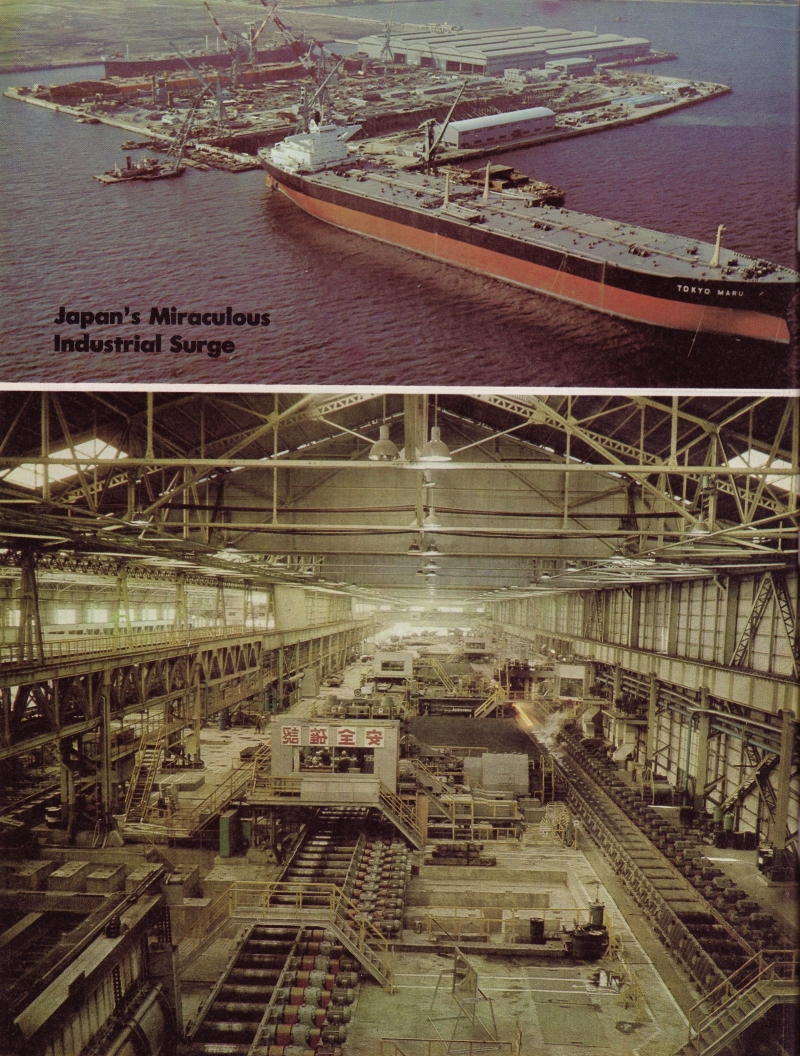In 20 short years, Japan has emerged from the smoking ruins of World War II
to become the SUPERGIANT of the Orient.
She ranks THIRD in the world — behind America and Russia — in Industrial Output — and still growing!
Here are the surprising FACTS behind this phenomenal growth, and what it portends for the future.
JAPAN'S sun has once again risen — and it is bigger and brighter than ever before!
From the rubble and ruin of World War II, a NEW JAPAN has emerged. A mighty economic SUPERGIANT. Japan's phenomenal post-war recovery has catapulted this once crushed and demoralized nation into the position of a MAJOR WORLD POWER and Asia's mightiest industrial nation.
Japan has written the most amazing and spectacular of all modern success stories. This story of Japan's economic rebirth is nothing short of phenomenal.
Uninformed Americans
Most people are unaware of the role Japan is destined to play in future world affairs.
The average man on the street is almost totally uninformed — or woefully misinformed — concerning the New Japan. The chances are that you fit into this category.
Even the government officials seem reluctant to face the reality of Japan's powerful economic position. Japan is no longer the vassal of her former conqueror. She is no longer willing to be told what to do. The time is almost here when Japan will be "calling the shots" in Southeast Asia.
|
Interfoto MTI
 |
|
TOKYO, JAPAN — Night shot shows famed Ginza strip
in the heart of the Japanese capital — the most populous city in the world.
|
"Oddly enough," admits former U.S. Ambassador to Japan Edwin O. Reischauer, "we are not in the habit of thinking of Japan as either big or great . . . Japan, however, is one of the biggest countries of the modern world as figured in any way but land area."
Professor Robert A. Scalapino, of the University of California, has warned: "Whatever the future may hold, Japan — not China — is today the major power of Asia, and one of the handful of major powers that will determine the future of the world."
Who would have believed such a statement twenty — or even ten — years ago? Now look at what has made the new Japan great.
Since World War II, Japan's population has skyrocketed by 50 percent. This makes the tiny island nation the world's fifth most populous nation. Only China, India, Russia, and the United States are larger than Japan's 101,000,000 population.
By 1951 — six short years after the war's total destruction — Japanese industrial output was back to prewar levels. And by 1967, Japan reached a tie for third place (with West Germany) in industrial output, and fourth (behind U.S., USSR and West Germany) in Gross National Product.
The amazing part of this economic miracle is Japan's growth rate. While the huge world powers are satisfied with a two or three percent yearly increase, Japan has averaged a level ten percent yearly increase for over a decade!
Today Japan is number one in production of ships, motorcycles, organs, transistor radios, quality cameras, and sewing machines. She is a close second or third in such all-important industries as steel, chemicals, automobiles, paper, and electronics.
"The Ships of Tarshish"
Japan lost 2,568 ships during World War II. Her merchant fleet was all but annihilated. Her bustling harbors and massive shipbuilding works were bombed beyond recognition.
|
Ishikowalima-Harima (Top) Nihon Hauhoku (Bottom)
 |
|
Top, Tokyo Maru, 152,400 ton supertanker completed in early 1966.
Today, this supertanker is a midget compared to new ones Japan has built.
Bottom, Hirohata Works steel mill.
|
But from these ruins, Japan — in Bible prophecy the "Tarshish" of the Orient — has assembled the world's fifth largest merchant fleet (with well over 10,000,000 gross tons), and the largest shipbuilding works ever known to man!
For twelve consecutive years, Japan has led the world in tons launched, now amounting to 47 percent of world production. In 1968 Japan may be able to produce over 50 percent of all shipping, or more than all the rest of the world combined!
Britain and West Germany combined produce less than half the Japanese tonnage.
Japan's future domination and growth in shipbuilding is insured by these two factors: 1) Contracts for ship bottoms, which have not yet started, account for fifty percent of the world's total; 2) Only Japanese shipyards have the present capacity to construct tankers between 200,000 and 300,000 DWT (deadweight tons). This gives Japan a virtual monopoly in the "supership" business.
Japan's "Superships"
Japan has revolutionized ship designing! Brilliant Japanese engineers and vast computer systems have automated the shipping industry, and — to no small extent — shipbuilding.
It's amazing to watch a Japanese "supership" being assembled. The Japanese put together a ship much like a jigsaw puzzle, with some of the pieces weighing 250 tons! Whole sections, such as the deckhouse or engine room, are pre-built and lifted into place by huge cranes. Since Japan has so many orders for these supertankers, much of the construction can be computerized.
Once launched, these ships "run themselves," with a crew of only thirty to "man the computers." The two largest ships in the world — both Japanese built — have a total crew of 29 and 32, respectively!
The first Japanese "supertanker" appeared in 1962 to help Japan import more raw materials. That first 132,000 DWT tanker was such a success, and brought in such huge profits, Japan decided to build more tankers — many more.
In December, 1966, the latest behemoth was launched, the Idemitsu Maru, a 210,000 DWT tanker, measuring 1,122 feet in length (longer than the Eiffel Tower is high), and generating 100,000 horsepower.
Just how much is 210,000 tons of oil? It staggers the imagination! The Idemitsu Maru could hold enough gasoline to drive 750 cars to the moon and back, AND enough kerosene to cook a big breakfast for every person on the face of the earth (and have enough left over to cook dinner for everybody, too), AND enough diesel fuel to drive 900 heavy trucks around the world at the equator, and still have enough fuel left in its hull to generate electricity to light all the light bulbs in Japan for two weeks!
On the return trip, the Idemitsu Maru could hold 1.3 billion bottles of soft drink, enough to supply every American man, woman and child with a six-pack!
But Japan is not satisfied! Japanese designers are already tackling the problem of the most efficient hull form for a 500,000 DWT vessel, hopefully to be built before 1980! No nation can stop Japan's technological monopoly on these "superships."
These modern-day "Ships of Tar-shish" are a direct fulfillment of Bible prophecy. (See the December, 1966 PLAIN TRUTH, pp. 22-23, for proof of the identity of the "Tarshish" of the Orient)